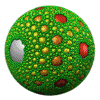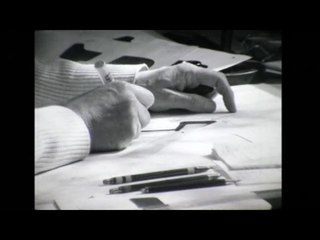The Portable Document Format (PDF) is a file format developed by Adobe in the 1990s to present documents, including text formatting and images, in a manner independent of application software, hardware, and operating systems. Based on the PostScript language, each PDF file encapsulates a complete description of a fixed-layout flat document, including the text, fonts, vector graphics, raster images and other information needed to display it. PDF was standardized as ISO 32000 in 2008, and no longer requires any royalties for its implementation.
PostScript (PS) is a page description language in the electronic publishing and desktop publishing business. It is a dynamically typed, concatenative programming language and was created at Adobe Systems by John Warnock, Charles Geschke, Doug Brotz, Ed Taft and Bill Paxton from 1982 to 1984.
TrueType is an outline font standard developed by Apple in the late 1980s as a competitor to Adobe's Type 1 fonts used in PostScript. It has become the most common format for fonts on the classic Mac OS, macOS, and Microsoft Windows operating systems.

Palatino is the name of an old-style serif typeface designed by Hermann Zapf, initially released in 1949 by the Stempel foundry and later by other companies, most notably the Mergenthaler Linotype Company.

A raster image processor (RIP) is a component used in a printing system which produces a raster image also known as a bitmap. Such a bitmap is used by a later stage of the printing system to produce the printed output. The input may be a page description in a high-level page description language such as PostScript, PDF, or XPS. The input can be or include bitmaps of higher or lower resolution than the output device, which the RIP resizes using an image scaling algorithm.

The LaserWriter is a laser printer with built-in PostScript interpreter sold by Apple Computer, Inc. from 1985 to 1988. It was one of the first laser printers available to the mass market. In combination with WYSIWYG publishing software like PageMaker, that operated on top of the graphical user interface of Macintosh computers, the LaserWriter was a key component at the beginning of the desktop publishing revolution.
Desktop publishing (DTP) is the creation of documents using page layout software on a personal ("desktop") computer. It was first used almost exclusively for print publications, but now it also assists in the creation of various forms of online content. Desktop publishing software can generate layouts and produce typographic-quality text and images comparable to traditional typography and printing. Desktop publishing is also the main reference for digital typography. This technology allows individuals, businesses, and other organizations to self-publish a wide variety of content, from menus to magazines to books, without the expense of commercial printing.

Halftone is the reprographic technique that simulates continuous-tone imagery through the use of dots, varying either in size or in spacing, thus generating a gradient-like effect. "Halftone" can also be used to refer specifically to the image that is produced by this process.
Encapsulated PostScript (EPS) is a Document Structuring Conventions–conforming (DSC) PostScript document format usable as a graphics file format. EPS files are more-or-less self-contained, reasonably predictable PostScript documents that describe an image or drawing and can be placed within another PostScript document. An EPS file is essentially a PostScript program, saved as a single file that includes a low-resolution preview "encapsulated" within it, allowing some programs to display a preview on the screen.

Helvetica or Neue Haas Grotesk is a widely used sans-serif typeface developed in 1957 by Swiss typeface designer Max Miedinger with input from Eduard Hoffmann.

Typesetting is the composition of text by means of arranging physical types or the digital equivalents. Stored letters and other symbols are retrieved and ordered according to a language's orthography for visual display. Typesetting requires one or more fonts. One significant effect of typesetting was that authorship of works could be spotted more easily, making it difficult for copiers who have not gained permission.

Matthew Carter is a British type designer. A 2005 New Yorker profile described him as 'the most widely read man in the world' by considering the amount of text set in his commonly used fonts.
Job Definition Format (JDF) is a technical standard being developed by the graphic arts industry to facilitate cross-vendor workflow implementations of the application domain. It is an XML format about job ticket, message description, and message interchange. JDF is managed by CIP4, the International Cooperation for the Integration of Processes in Prepress, Press and Postpress Organization. JDF was initiated by Adobe Systems, Agfa, Heidelberg and MAN Roland in 1999 but handed over to CIP3 at Drupa 2000. CIP3 then renamed itself CIP4.

Transparency is possible in a number of graphics file formats. The term "transparency" is used in various ways by different people, but at its simplest there is "full transparency" i.e. something that is completely invisible. Only part of a graphic should be fully transparent, or there would be nothing to see. More complex is "partial transparency" or "translucency" where the effect is achieved that a graphic is partially transparent in the same way as colored glass. Since ultimately a printed page or computer or television screen can only be one color at a point, partial transparency is always simulated at some level by mixing colors. There are many different ways to mix colors, so in some cases transparency is ambiguous.
Ikarus is a type design and production software developed by URW foundry, for converting existing typefaces and logos into digital format for use on computer driven printing, plotting and sign cutting devices.
A computer font is implemented as a digital data file containing a set of graphically related glyphs, characters, or symbols such as dingbats. Although the term font first referred to a set of movable metal type pieces in one style and size, since the 1990s it is generally used to refer to a set of digital shapes in a single style, scalable to different sizes. A font family or typeface refers to the collection of related fonts across styles and sizes.

A graphic designer is a professional within the graphic design and graphic arts industry who assembles together images, typography, or motion graphics to create a piece of design. A graphic designer creates the graphics primarily for published, printed or electronic media, such as brochures (sometimes) and advertising. They are also sometimes responsible for typesetting, illustration, user interfaces, and web design. A core responsibility of the designer's job is to present information in a way that is both accessible and memorable.

In metal typesetting, a font was a particular size, weight and style of a typeface. Each font was a matched set of type, one piece for each glyph, and a typeface consisting of a range of fonts that shared an overall design.
In printing, Preflight is the process of confirming that the digital files required for the printing process are all present, valid, correctly formatted, and of the desired type. The basic idea is to prepare the files to make them feasible for the correct process such as offset printing and eliminate costly errors and facilitate a smooth production. It is a standard prepress procedure in the printing industry. The term originates from the preflight checklists used by pilots. The term was first used in a presentation at the Color Connections conference in 1990 by consultant Chuck Weger, and Professor Ron Bertolina was a pioneer for solutions to preflighting in the 1990s.
Apple's Macintosh computer supports a wide variety of fonts. This support was one of the features that initially distinguished it from other systems.









